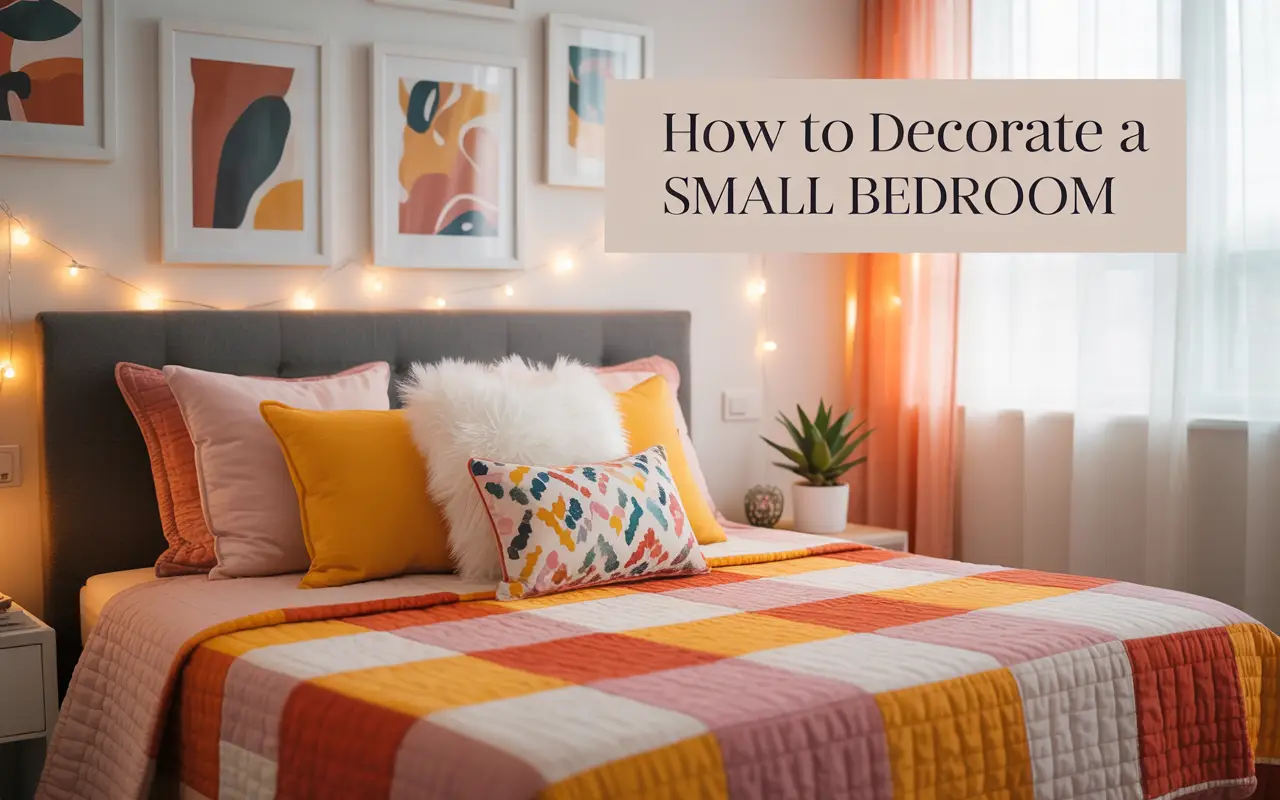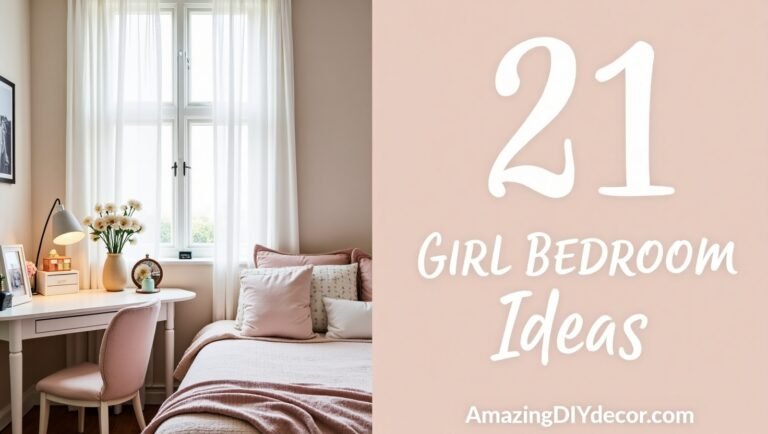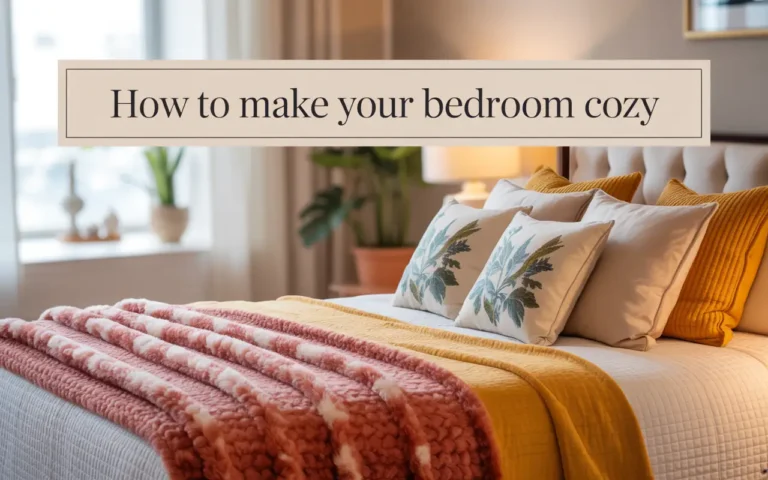How To Decorate a Small Bedroom: Smart, Stylish & Space-Saving Ideas
Living in a small space doesn’t mean you have to sacrifice style. A compact bedroom can feel just as luxurious and comfortable as a larger one with the right design choices. The key is to think smart, using every inch of your room to its fullest potential without making it feel cramped or cluttered. It’s about creating a space that’s not only functional but also a true reflection of your personality—a cozy sanctuary where you can unwind and recharge.
This guide will walk you through 15 practical and stylish ideas to transform your small bedroom. From clever furniture choices to optical illusions that create a sense of space, these tips will help you maximize your square footage. You’ll learn how to make your room feel brighter, more organized, and uniquely yours.
Table of Contents
Start with a Light Color Palette
Color has a profound impact on how we perceive a space. When decorating a small bedroom, your color palette is one of the most powerful tools at your disposal. Light and soft colors—think crisp whites, warm creams, soft grays, and delicate pastels—are your best friends. These hues are excellent at reflecting natural and artificial light, which instantly makes a room feel more open, airy, and expansive. A darker color tends to absorb light, which can make walls feel like they’re closing in, creating a cozy but sometimes cramped atmosphere.
To implement this, consider painting your walls a light, neutral shade. Benjamin Moore’s “Chantilly Lace” is a brilliant, clean white that works in almost any lighting, while Sherwin-Williams’ “Agreeable Gray” offers a soft, warm greige that provides a hint of color without overwhelming the space. Don’t forget the ceiling; painting it a bright white, or even a shade lighter than your walls, can draw the eye upward and enhance the feeling of height. For a touch of personality, you can introduce subtle pops of color through your decor, like pale blue throw pillows or a soft sage green blanket. This strategy allows you to maintain a bright, spacious foundation while still infusing the room with character.
Choose Multi-Functional Furniture
In a small bedroom, every piece of furniture needs to work hard. Single-purpose items can quickly eat up valuable floor space, so prioritizing multi-functional furniture is a game-changer. This approach allows you to meet all your needs—for sleeping, storage, and even working—without overcrowding the room. It’s about being resourceful and selecting pieces that offer more than one benefit. For instance, instead of a simple bed frame, look for one with built-in drawers underneath. This provides a hidden spot to stash away extra bedding, seasonal clothing, or shoes, eliminating the need for a separate, bulky dresser.
Similarly, an ottoman with a lift-off top can serve as a comfortable seat, a small side table for a tray of tea, and a storage container for books or blankets. If you need a workspace, consider a floating desk that folds down when not in use or a narrow console table that can double as a vanity. Nightstands can also be more than just a surface for your lamp. Look for designs with shelves or drawers to keep your nighttime essentials organized and out of sight. By choosing furniture that cleverly combines form and function, you can keep your bedroom tidy and maximize every square foot, creating a space that feels both practical and uncluttered.
Use Mirrors to Create the Illusion of Space
Mirrors are a classic and highly effective trick for making any small room feel larger. Their ability to reflect light and views creates an illusion of depth, essentially tricking the eye into perceiving more space than is actually there. Placing a large mirror on a wall can visually double the size of the room, making it feel more open and less confined. The key is strategic placement. For maximum impact, hang a large floor-length mirror or a wide horizontal mirror on the wall opposite a window. This will capture the natural light and the view from outside, bringing the brightness and openness of the outdoors into your bedroom.
You can also use mirrors in more creative ways. Consider a mirrored closet door, which serves a practical purpose while also enhancing the sense of space. Grouping several smaller mirrors together can create an interesting and reflective art piece. Placing a mirror behind a nightstand or a lamp can amplify the light from the bulb, adding a warm and inviting glow to the room in the evenings. Whether you choose a sleek, modern design or an ornate, vintage frame, a mirror acts as a decorative “window,” adding both style and a much-needed sense of spaciousness to your compact bedroom.
Maximize Vertical Space
When floor space is limited, the only way to go is up. Maximizing vertical space is a fundamental principle of small-space living, allowing you to add storage and function without cluttering your walking paths. By drawing the eye upward, you also create an illusion of height, making the room feel grander. Instead of wide, low bookcases or dressers, opt for tall, slender alternatives that make the most of the wall height. A tallboy dresser offers the same amount of storage as a traditional one but with a much smaller footprint.
Floating shelves are another excellent way to utilize wall space. You can install them above your bed, desk, or dresser to display books, plants, and decorative items without taking up any floor real estate. For clothing, consider a wardrobe that extends close to the ceiling, providing ample storage for everything from coats to shoes. Wall-mounted hooks are a simple yet effective solution for hanging bags, hats, and scarves, keeping them organized and off the floor. Even your lighting can be wall-mounted; sconces instead of table lamps free up your nightstand surfaces. By thinking vertically, you can create a highly organized and functional bedroom that feels open and uncluttered.
Go Minimal with Decor
In a small bedroom, less is truly more. While it can be tempting to fill your space with personal treasures and decorative items, over-accessorizing can quickly lead to a sense of chaos and clutter. A minimalist approach to decor helps create a calm, serene, and visually spacious environment. This doesn’t mean your room has to be boring or devoid of personality. It’s about being intentional with your choices and selecting a few key pieces that make a statement without overwhelming the space.
Start by decluttering your surfaces. Keep your nightstand and dresser tops as clear as possible, limiting them to essential items like a lamp, a book, and perhaps a small tray for jewelry. When it comes to wall art, choose one or two larger framed prints instead of a busy gallery wall of many small pictures. A single, impactful piece of art can serve as a beautiful focal point without making the walls feel crowded. For textiles, a cozy throw blanket at the foot of the bed or a few well-chosen decorative pillows can add texture and color. The goal is to let your room breathe. Each decorative item should have a purpose and enough space around it to be appreciated, contributing to a feeling of curated calm rather than disorganized clutter.
Pick the Right Bed Size
The bed is typically the largest piece of furniture in a bedroom, and its size can make or break the functionality of a small space. While a sprawling, king-sized bed might seem like the height of luxury, it can completely overwhelm a compact room, leaving little to no space for movement or other essential furniture. Choosing the right bed size is crucial for creating a balanced and comfortable layout. For most small bedrooms, a double (full) or queen-sized bed is a much more practical choice. These sizes provide ample sleeping space for one or two people without dominating the entire room.
Beyond the mattress size, the design of the bed frame itself also matters. Avoid bulky, ornate headboards and footboards, as they can visually and physically shrink the space. Opt for a bed with a simple, clean-lined frame or a low-profile headboard. A platform bed or a frame with slim metal legs can create a sense of openness underneath, allowing light and air to flow more freely and making the room feel larger. By carefully selecting a bed that is proportionate to the room, you’ll free up valuable floor space for nightstands, a small dresser, or simply a clear path to walk around, making your bedroom both comfortable and navigable.
Use Under-Bed Storage
One of the most underutilized storage areas in any bedroom is the space beneath the bed. In a small room where every inch counts, harnessing this hidden real estate is a non-negotiable strategy for staying organized. Using under-bed storage allows you to tuck away items you don’t need daily access to, freeing up precious closet and drawer space for your everyday essentials. This is the perfect spot for storing seasonal clothing, such as bulky winter sweaters or summer dresses, as well as extra linens, blankets, and shoes.
There are several ways to make use of this space. Many bed frames are designed with built-in drawers, offering a seamless and tidy solution. If your current bed frame has clearance underneath, you can purchase shallow storage bins or fabric bags, preferably with wheels for easy access. Clear containers are particularly useful as they allow you to see what’s inside at a glance. For a more streamlined look, a bed skirt can conceal the storage containers while adding a soft, decorative touch. By moving lesser-used items out of sight and into this otherwise wasted space, you can significantly reduce clutter and create a more serene and organized bedroom environment.
Add Soft Lighting Layers
Lighting plays a critical role in setting the mood and enhancing the perception of space in a room. A single, harsh overhead light can cast unflattering shadows and make a small bedroom feel flat and uninviting. The key to creating a warm, dynamic, and spacious atmosphere is to use layered lighting. This involves combining different types of light sources—ambient, task, and accent—to create a balanced and flexible lighting scheme. Instead of relying on bulky floor or table lamps that consume valuable surface area, look for space-saving alternatives.
Wall sconces mounted on either side of the bed are a fantastic choice, as they provide perfect reading light while freeing up your nightstands. A stylish pendant light hanging from the ceiling can serve as both a beautiful focal point and a source of ambient light. For a touch of whimsy and soft accent lighting, consider stringing fairy lights around your headboard or along a shelf. Placing a dimmer switch on your main light source is another great idea, allowing you to adjust the intensity from bright and functional to soft and relaxing. By layering different light sources, you can add depth, warmth, and visual interest to your bedroom, making it feel cozier and more expansive.
Incorporate Sliding Doors
Traditional swing doors require a significant amount of clear floor space to open and close, which can be a major inconvenience in a small bedroom. Every time you open a closet or bathroom door, you are effectively losing several square feet of usable space. A simple and elegant solution to this problem is to replace swing doors with sliding ones. Sliding doors, such as pocket doors that disappear into the wall or barn doors that glide along a track, operate parallel to the wall, requiring virtually no floor space to function.
This change can dramatically improve the flow and layout of your room. With a sliding closet door, you can place furniture closer to the closet without worrying about blocking access. In an en-suite bathroom, a sliding door can make the transition between the two spaces feel more seamless and open. This not only maximizes your usable square footage but also contributes to a cleaner, more modern aesthetic. While installing a pocket door can be a more involved renovation, surface-mounted barn doors are relatively easy to install and can add a stylish, rustic, or industrial touch to your decor, depending on the hardware you choose.
Also Read:
How To Decorate A Bedroom
Add a Statement Piece
A minimalist approach doesn’t mean your room has to be devoid of personality. In fact, a small bedroom is the perfect setting for a single, carefully chosen statement piece. An eye-catching item can act as a focal point, drawing attention and adding a dose of character and style without overwhelming the space. The key is to choose one element to be the star of the show. This could be a bold, upholstered headboard in a vibrant color or interesting pattern, which anchors the bed and adds a touch of luxury.
Alternatively, you could create an accent wall behind your bed using a dramatic paint color, a unique wallpaper, or textured paneling. This draws the eye and creates an illusion of depth. A beautiful, oversized piece of art hung above the bed can also serve as a powerful focal point. If you prefer to keep your walls simple, consider a unique area rug with a striking pattern or rich texture. This can ground the space and inject personality from the floor up. By focusing on one standout element, you can make a big design impact while keeping the rest of the room relatively simple and uncluttered, achieving a look that is both stylish and spacious.
Keep It Organized
No matter how well you decorate, a cluttered room will always feel small and stressful. Consistent organization is perhaps the most important habit for maintaining a serene and spacious-feeling bedroom. A clutter-free environment not only looks better but also promotes a sense of calm and relaxation. To achieve this, it’s essential to have a designated place for everything. Small, decorative storage solutions can be both functional and stylish. Use attractive baskets or fabric boxes on shelves or in closets to corral smaller items like accessories, electronics, and toiletries.
Inside your drawers, use dividers to neatly separate socks, underwear, and other clothing items. This makes it easier to find what you need and prevents drawers from becoming a jumbled mess. Adopt the “one in, one out” rule: every time you bring a new item into your room, get rid of an old one. This prevents accumulation and forces you to be mindful of your purchases. Taking just five minutes at the end of each day to put things back in their proper place—hanging up clothes, clearing your nightstand, and making your bed—can make a world of difference. An organized room instantly feels larger, brighter, and more tranquil.
Bring in Plants
Plants are a simple and affordable way to breathe life and freshness into any room, and small bedrooms are no exception. Greenery adds a touch of nature, improves air quality, and can have a calming, stress-reducing effect. In a compact space, you don’t need a large, potted tree to make an impact. A few small, well-placed plants can add color, texture, and vitality without taking up precious real estate.
Look for plants that are suitable for smaller spaces and lower light conditions, which are common in bedrooms. A snake plant or a ZZ plant are excellent choices as they are low-maintenance and have a sleek, vertical growth habit. You can place a small potted plant, like a succulent or an air plant, on your nightstand or a bookshelf. To save even more space, think vertically. Hanging plants, such as a pothos or an English ivy, are perfect for small rooms. You can hang them from the ceiling in a corner or let them trail down from a high shelf, adding a beautiful cascade of green without cluttering any surfaces. This touch of nature can make your bedroom feel more vibrant, airy, and connected to the outdoors.
Hang Curtains High
Windows play a crucial role in how large a room feels, and how you dress them can significantly enhance that perception. A common mistake is to hang curtain rods right above the window frame, which can make the window—and the ceiling—feel lower than they actually are. A simple yet highly effective designer trick is to mount your curtain rods as high as possible, just a few inches below the ceiling. This draws the eye upward, creating a powerful illusion of height and making the entire room feel taller and more grand.
In addition to hanging them high, extend the curtain rod several inches beyond the window frame on each side. This allows you to pull the curtains completely clear of the window when they are open, maximizing the amount of natural light that floods into the room and making the window itself appear wider. Choose long curtain panels that skim the floor, as curtains that are too short can visually chop up the wall. Light-colored, lightweight fabrics like linen or sheer cotton are ideal for small bedrooms, as they allow light to filter through even when closed, maintaining a bright and airy feel.
Use a Minimalist Theme
Adopting a minimalist design theme is a natural fit for decorating a small bedroom. Minimalism is rooted in the principle of “less is more,” focusing on clean lines, simple forms, and a lack of unnecessary ornamentation. This aesthetic creates a sense of order and serenity that can make a compact space feel open, calm, and uncluttered. A minimalist theme doesn’t mean your room has to feel cold or sterile; it’s about curating a space with intentionality, where every item has a purpose and a place.
To achieve a minimalist look, start with a restrained color palette, typically centered around neutral tones like white, beige, and gray. Stick to furniture with simple, geometric shapes and clean silhouettes. Avoid pieces with elaborate details or heavy ornamentation. Keep surfaces as clear as possible, storing items away in concealed storage. The beauty of minimalism lies in its simplicity and its focus on quality over quantity. Each piece of furniture, art, and decor is carefully chosen to contribute to a cohesive and tranquil whole. This deliberate simplicity not only makes your room feel larger but also turns it into a peaceful retreat from the visual noise of the outside world.
Personalize with Textures
A room dominated by clean lines and neutral colors can sometimes risk feeling a bit flat or cold. This is where texture comes in. Layering different textures is a sophisticated way to add depth, warmth, and personality to your bedroom without introducing visual clutter. Texture engages the sense of touch and adds a layer of richness that makes a space feel cozy, inviting, and thoughtfully designed. Even within a monochrome or neutral color scheme, a variety of textures can create significant visual interest.
Think about incorporating a mix of soft, rough, smooth, and plush materials. You could lay a soft, high-pile wool or shag rug on the floor to add warmth underfoot. On the bed, combine smooth cotton sheets with a chunky knit throw blanket and perhaps a velvet or linen decorative pillow. The headboard could be upholstered in a tactile fabric like bouclé or natural linen. Consider your window treatments as well—a lightweight, gauzy linen curtain adds a soft, ethereal quality. Even small decorative objects, like a ceramic vase or a wooden tray, contribute to the textural landscape of the room. By thoughtfully layering these different materials, you can create a space that feels rich, complex, and deeply personal.
Make Your Small Space Shine
Decorating a small bedroom is an exercise in creativity and smart design. By using a light color palette, choosing multi-functional furniture, and maximizing vertical space, you can lay a functional and spacious foundation. Tricks like using mirrors, hanging curtains high, and layering your lighting will enhance the sense of openness, while a minimalist approach to decor keeps the space feeling calm and uncluttered.
Most importantly, don’t forget to infuse your personality into the room. A well-chosen statement piece, a few beloved plants, and a rich mix of textures will transform your small space from just a room into a true sanctuary. With these strategies, you can create a stylish, comfortable, and highly personal bedroom that you’ll love spending time in, proving that great style can come in any size.






